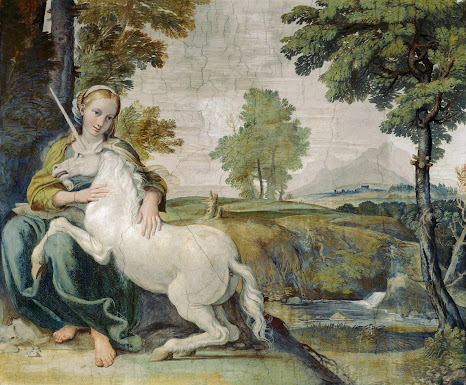Unicorns
The unicorn is a legendary creature that has been described since antiquity as a beast with a single large, pointed, spiralling horn projecting from its forehead.
The earliest written description of a unicorn comes from a book written in the 5th century BC. Indica or Indika contains a mix of dubious stories and myths about the East, possibly India, compiled by the Greek physician and historian Ctesias the Cnidian. Ctesias was the physician to the king of the Achaemenid Empire, Artaxerxes II (c435-358 BC). As part of his role, Ctesias accompanied the king on various expeditions and battles and, therefore, became well acquainted with the neighbouring lands. This allowed the physician to pen treatises on rivers and lands, including Persia and India. Some of the information is based on first-hand experience, however, the rest was pieced together through various stories told by travellers.
As early as the 6th century, theories were expressed as to why unicorns were rarely seen. Cosmas Indicopleustes, a 6th-century Greek merchant from Alexandria of Egypt reported, “it is impossible to take this ferocious beast alive; and that all its strength lies in its horn. When it finds itself pursued and in danger of capture, it throws itself from a precipice, and turns so aptly in falling, that it receives all the shock upon the horn, and so escapes safe and sound.” Cosmos also wrote a series of books about scientific geography known collectively as Christian Topography. Cosmas aimed to convince people of his theory that the earth was modelled on the tabernacle described to Moses by God in the Book of Exodus. His view was the earth was flat and the heavens formed the shape of a box with a curved lid.
There are two common jokes about why unicorns may no longer exist. The first is the unicorns did not get on Noah’s ark in time and the second that they did get on the ark, but they were both males. Incidentally, unicorns are traditionally believed to be male and none of the myths, legends or bestiaries shed light on how they reproduce. The only claim about their nature is they are solitary creatures and can live for hundreds of years.
Ancient writers such as Ctesias and Aelian recorded that a unicorn’s horn, made from a substance called alicorn, could be made into a vessel that when drunk from would protect against diseases and poisons. Other parts of the body of a unicorn were also considered to have medicinal properties. The 12th century Abbess Saint Hildegard of Bingen wrote a recipe for an ointment to cure leprosy. The ingredients included egg yolk and foie de licorne, also known as unicorn liver.
Royalty was often given alicorns as gifts. Queen Elizabeth I of England was said to own a unicorn horn and the Throne Chair of Denmark was said to be made from many horns. Commissioned by King Frederick III (1609-70) in 1662, the throne was made by Bendix Grodtschilling (1620-90) to resemble the Biblical Throne of King Solomon described in 1 Kings 10. The throne was used at coronations until 1849 when the Danish monarchy was replaced by a constitutional monarchy. The unicorn horns, however, have since been proved to be narwhal tusks.
Keywords
Symbol
Cloven
Heraldry
Damsal
Traditional
Elaborate
Ruse
Equivalent
Graceful
Essence
Supernatural
Mystical
Marvellous
Innocence
The gentle and pensive maiden has the power to tame the unicorn, fresco by Domenichino, c. 1604–05 (Palazzo Farnese, Rome)[
What does a unicorn call his dad?
Popcorn!




Comments
Post a Comment